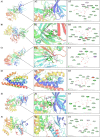Integrated Pharmaco-Bioinformatics Approaches and Experimental Verification To Explore the Effect of Britanin on Nonalcoholic Fatty Liver Disease
- PMID: 38405493
- PMCID: PMC10882692
- DOI: 10.1021/acsomega.3c08968
Integrated Pharmaco-Bioinformatics Approaches and Experimental Verification To Explore the Effect of Britanin on Nonalcoholic Fatty Liver Disease
Abstract
Nonalcoholic fatty liver disease (NAFLD) is a prevalent global liver disorder, posing substantial health risks. Britanin, a bioactive sesquiterpene lactone extracted from Inula japonica, has demonstrated antidiabetic, hypolipidemic, and hepatoprotective attributes. Nonetheless, the precise impact of Britanin on NAFLD and the intricate biological mechanisms underpinning this interaction remain unexplored. We integrated computer-aided methods to unearth shared biological targets and signaling pathways associated with both Britanin and NAFLD. A network was constructed by compiling putative targets associated with Britanin and NAFLD, followed by a stringent screening of key targets and mechanisms through protein-protein interaction analysis along with GO and KEGG pathway enrichment analyses. Molecular docking was integrated as an evaluation tool, culminating in the identification of HO-1 as the pivotal therapeutic target, showcasing a satisfactory binding affinity. The primary mechanism was ascribed to biological processes and pathways linked to oxidative stress, as evidenced by the outcomes of enrichment analyses. Of these, the AMPK/SREBP1c pathway assumed centrality in this mechanism. Furthermore, in vivo experiments substantiated that Britanin effectively curtailed NAFLD development by ameliorating liver injury, modulating hyperlipidemia and hepatic lipid accumulation, and alleviating oxidative stress and apoptosis. In summary, this study demonstrates the potential of Britanin as a promising therapeutic drug against NAFLD.
© 2024 The Authors. Published by American Chemical Society.
Conflict of interest statement
The authors declare no competing financial interest.
Figures








Similar articles
-
Target Deconvolution of Fenofibrate in Nonalcoholic Fatty Liver Disease Using Bioinformatics Analysis.Biomed Res Int. 2021 Dec 26;2021:3654660. doi: 10.1155/2021/3654660. eCollection 2021. Biomed Res Int. 2021. PMID: 34988225 Free PMC article.
-
Explore the Mechanism of Astragalus mongholicus Bunge against Nonalcoholic Fatty Liver Disease Based on Network Pharmacology and Experimental Verification.Gastroenterol Res Pract. 2022 Apr 5;2022:4745042. doi: 10.1155/2022/4745042. eCollection 2022. Gastroenterol Res Pract. 2022. PMID: 35422858 Free PMC article.
-
Molecular mechanism of Fufang Zhenzhu Tiaozhi capsule in the treatment of type 2 diabetes mellitus with nonalcoholic fatty liver disease based on network pharmacology and validation in minipigs.J Ethnopharmacol. 2021 Jun 28;274:114056. doi: 10.1016/j.jep.2021.114056. Epub 2021 Mar 23. J Ethnopharmacol. 2021. PMID: 33771638
-
Britanin - a beacon of hope against gastrointestinal tumors?World J Clin Oncol. 2024 Apr 24;15(4):523-530. doi: 10.5306/wjco.v15.i4.523. World J Clin Oncol. 2024. PMID: 38689621 Free PMC article. Review.
-
Natural compounds against nonalcoholic fatty liver disease: A review on the involvement of the LKB1/AMPK signaling pathway.Phytother Res. 2023 Dec;37(12):5769-5786. doi: 10.1002/ptr.8020. Epub 2023 Sep 25. Phytother Res. 2023. PMID: 37748097 Review.
References
-
- McPherson S.; Armstrong M. J.; Cobbold J. F.; Corless L.; Anstee Q. M.; Aspinall R. J.; Barclay S. T.; Brennan P. N.; Cacciottolo T. M.; Goldin R. D.; Hallsworth K.; Hebditch V.; Jack K.; Jarvis H.; Johnson J.; Li W.; Mansour D.; McCallum M.; Mukhopadhya A.; Parker R.; Ross V.; Rowe I. A.; Srivastava A.; Thiagarajan P.; Thompson A. I.; Tomlinson J.; Tsochatzis E. A.; Yeoman A.; Alazawi W. Quality standards for the management of non-alcoholic fatty liver disease (NAFLD): consensus recommendations from the British Association for the Study of the Liver and British Society of Gastroenterology NAFLD Special Interest Group. Lancet Gastroenterol Hepatol 2022, 7 (8), 755–769. 10.1016/S2468-1253(22)00061-9. - DOI - PMC - PubMed
LinkOut - more resources
Full Text Sources
